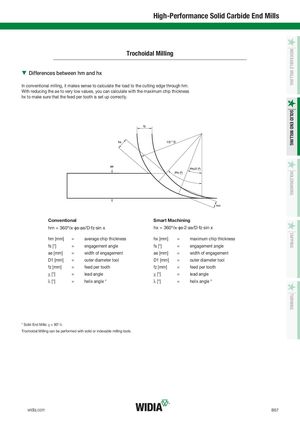Каталог Widia all star 2020 - страница 179
Навигация
- TABLE OF CONTENTS
- INDEXABLE MILLING
- 0º/90º SHOULDER MILLS
- 90° HIGH-SPEED CUTTING MILLS
- FACE MILLS
- HIGH-FEED MILLS
- COPY MILLS
- SOLID END MILLING
- HIGH-PERFORMANCE SOLID CARBIDE END MILLS
- GENERAL PURPOSE SOLID CARBIDE END MILLS
- HOLEMAKING
- SOLID CARBIDE DRILLS
- MODULAR DRILLS
- INDEXABLE DRILLS
- TAPPING
- TURNING
- HIGH-PERFORMANCE INSERTS
- GROOVING & CUT-OFF
- Informational Icons Guide
- Material Overview • DIN

TURNINGTAPPINGHOLEMAKINGSOLID END MILLINGINDEXABLE MILLING High-Performance Solid Carbide End Mills Trochoidal Milling TTDifferences between hm and hx In conventional milling, it makes sense to calculate the load to the cutting edge through hm. With reducing the ae to very low values, you can calculate with the maximum chip thickness hx to make sure that the feed per tooth is set up correctly. Conventional Smart Machining hm = 360º/p∙fs∙ae/D∙fz∙sin x hx = 360º/p∙fs∙2∙ae/D∙fz∙sin x hm [mm] = average chip thickness hx [mm] = maximum chip thickness fs [°] = engagement angle fs [°] = engagement angle ae [mm] = width of engagement ae [mm] = width of engagement D1 [mm] = outer diameter tool D1 [mm] = outer diameter tool fz [mm] = feed per tooth fz [mm] = feed per tooth c [°] = lead angle c [°] = lead angle l [°] = helix angle * l [°] = helix angle * * Solid End Mills: c = 90°-l Trochoidal Milling can be performed with solid or indexable milling tools. widia.com B57
 Каталог Widia техническое руководство по разверткам
Каталог Widia техническое руководство по разверткам Каталог Widia достижения 2020
Каталог Widia достижения 2020 Каталог Widia инструмент для обработки отверстий 2017
Каталог Widia инструмент для обработки отверстий 2017 Каталог Widia монолитный инструмент 2017
Каталог Widia монолитный инструмент 2017 Каталог Widia цельные концевые фрезы
Каталог Widia цельные концевые фрезы